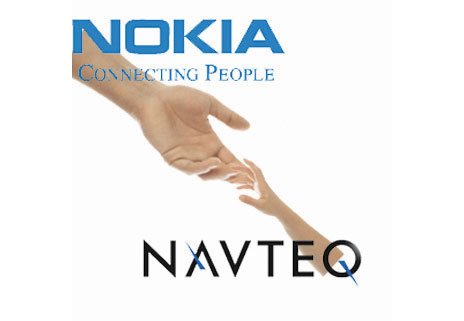Navteq Corp. has 1,000 analysts who drive around in vehicles
outfitted with computers, microphones and high-resolution video
cameras, gathering digital information on everything from landmarks
to bridge heights to street closings. Now the Chicago-based company
wants to recruit an additional billion data collectors: cell phone
users.
Navteq Corp. has 1,000 analysts who drive around in vehicles outfitted with computers, microphones and high-resolution video cameras, gathering digital information on everything from landmarks to bridge heights to street closings. Now the Chicago-based company wants to recruit an additional billion data collectors: cell phone users.
Digital map-maker Navteq is preparing for a significant leap from portable GPS devices and automobile navigation systems to the cell phone, and it is joining with the world’s largest handset manufacturer, Nokia Corp., to do it.
Navteq Chief Executive Judson Green sees the mobile phone as the key to expanding both Navteq’s geographic reach and the breadth of information it can provide.
“We’re excited about tapping into the Nokia community of consumers – of which there are close to a billion around the world – who can give us input as to what they find when they’re traveling,” Green told the Chicago Tribune in an interview. “We love the idea of having that consumer input funneled back to us because it allows us to make the map more accurate, to keep it fresh and to make it more interesting.”
Nokia commands about 40 percent of the global market for cell phones, and it has a strong presence in emerging markets such as India and China, where Navteq is eager to invest. In October the Finnish handsetmaker announced a deal to acquire Navteq for $8.1 billion. The Chicago firm would continue as a wholly owned subsidiary, keeping its local headquarters and Green as CEO.
The European Commission, which opened an inquiry into the Nokia-Navteq deal in March, is expected to approve the transaction by its Aug. 8 deadline. Once the acquisition is complete Navteq can push more aggressively into developing countries where the cell phone “is the central piece of technology,” Green said.
“We’re just beginning to see the wave of growth that will occupy the next several years,” he said. “Ultimately, you will find maps on every phone and you’ll find location-based content on every phone. … If our heritage was in the automotive sector and you think about a consumer behind the wheel, our future is with mobile consumers, or pedestrians.”
A cell phone could also be a live probe, Green said, noting that real-time data about how quickly a handset is moving could provide clues as to the speed of traffic in a particular area. He added that user-generated content will not be the dominant way Navteq builds its maps. The company uses a wealth of sources, such as satellite imagery and aerial photography.
Analysts expect the European Commission to clear the acquisition because in May it approved Dutch GPS device-maker TomTom’s $4.3 billion acquisition of TeleAtlas, Navteq’s only other rival.
Regulators “managed to get the TeleAtlas-TomTom deal done, which was probably the harder of the two, given the inter-relationship between those companies,” said analyst Brandon Dobell of William Blair & Co. in Chicago. “With that being pushed through, I would expect Navteq-Nokia to get done.”
Green is already looking at how the Nokia deal will enable Navteq’s expansion. Both Green and analysts expect Navteq will have more flexibility to invest without worrying about missing quarterly guidance and facing the shareholder scrutiny that comes with public ownership.
“Nokia doesn’t really get this business, so they’re leaving a lot of what Navteq does alone,” Dobell said. “They don’t know about how to drive around with trucks and get data.”
Green said he wants to get into so-called dynamic content such as data on gas prices and parking. Navteq has made a major push into traffic information, including opening a new center at its headquarters on West Randolph Street in late 2007. The traffic studio serves local broadcasters.
But as Navteq looks at creating other kinds of location-based content it will come up against niche competitors that are already developing cell-phone software related to geography.
These programs, which can be subscription-based or subsidized by advertising, provide services such as localized directory searches, restaurant recommendations and pedestrian navigation help.
Navteq will “have to be a bit creative when it comes to how they grow their business model,” said Michelle Warren, an analyst at Info-Tech Research Group.
“They might look at acquiring some of the smaller companies or partnering with them, because what Navteq can do is bring their brand name to the table and bring partnerships with all the device manufacturers,” she said. “They’ve been very strategic in how they’ve built up those partnerships.”
Analysts say an increasing number of mobile phone users are starting to use location-based services on their handsets, though growth is taking off from a low base. Research firm Gartner Inc. forecasts that the global number of subscribers to these services will total 43.2 million in 2008, compared with 16 million in 2007, and hit almost 300 million in 2011.
Revenue from these services, which include anything from mapping nearby retailers to pinpointing the real-time location of friends, is expected to exceed $8 billion in 2011.
“I don’t see us in the future getting involved in content that might be Wall Street quotes or sports scores or things which are not really location based,” Green said. “But if location is a factor, then we’re going to be involved in it for sure.”
Green, 55, joined Navteq in 2000 when the digital map-maker was owned by Philips Electronics, and he took the firm public in 2004.
Dobell said Green might stay on for a year or so after the Nokia acquisition, then leave for another business or just focus on his music – the Navteq CEO is an avid jazz pianist.
When asked if he was planning to stay, Green praised the firm and its prospects.
“We have a very exciting future and we’ve got a great team and we’re continuing to grow, so these are really exciting drivers for me,” Green said.















